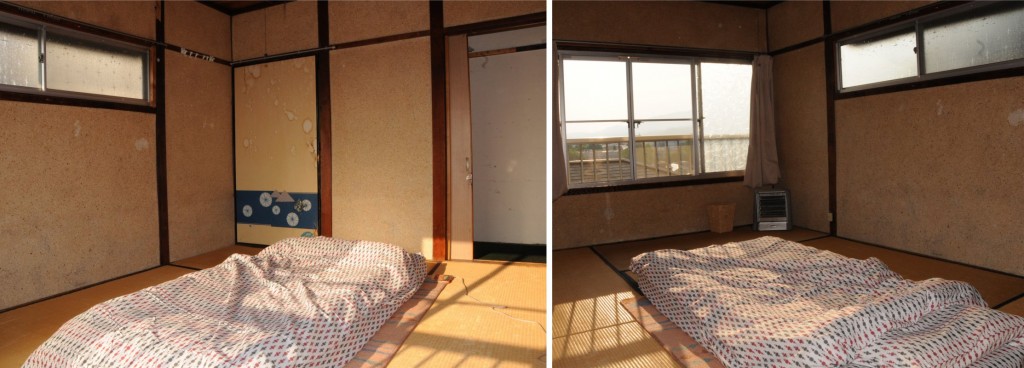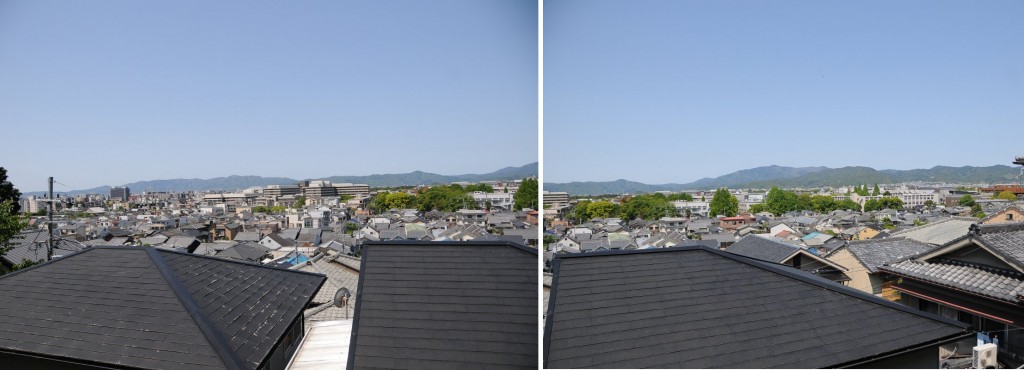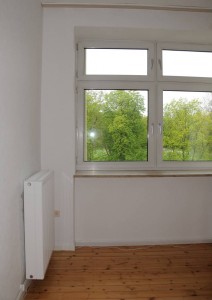The place I am staying in until I’ll get a job and a decent apartment is called a “gaijin house”, a sort of student’s dormitory for foreigners with private rooms and shared facilities. It is a way to stay for a longer time without resorting to expensive hotels or couch surfing. My tandem partner Tomoko even once stayed in a gaijin house – she said she wanted to brush up her English at that time.
I stay in Ebisu’s, an 80 year old traditional Japanese house near Kyoto University. Here is my new room:
 It’s a beautiful traditional Japanese room with straw mats (tatami) on the floor; one tatami is about 1×2 metres large, so my room with six tatami has about 12 square metres. The left door you can see above is the door to the wardrobe, this is about one square metre extra. Tatami, despite looking very robust, are rather delicate, so you’re only allowed to enter with socks. Also, as they can bear no heavy furniture, those rooms are usually empty, but this has the advantage that they can be used in any manner imaginable. In the photo you can see the futon I have put in the middle of the room, since then I have added a small low table to one corner at which I’m sitting right now. Usually, you do everything in these rooms kneeling on the floor. I don’t mind that at all, in fact I have liked to do this since I was a child. Sleeping on the futon on top of the tatami is great also, and as you should remove the futon every day as way of making your bed (although I may be too lazy to do this…), it means that you are not squandering precious space on a bed you don’t need during the day.
It’s a beautiful traditional Japanese room with straw mats (tatami) on the floor; one tatami is about 1×2 metres large, so my room with six tatami has about 12 square metres. The left door you can see above is the door to the wardrobe, this is about one square metre extra. Tatami, despite looking very robust, are rather delicate, so you’re only allowed to enter with socks. Also, as they can bear no heavy furniture, those rooms are usually empty, but this has the advantage that they can be used in any manner imaginable. In the photo you can see the futon I have put in the middle of the room, since then I have added a small low table to one corner at which I’m sitting right now. Usually, you do everything in these rooms kneeling on the floor. I don’t mind that at all, in fact I have liked to do this since I was a child. Sleeping on the futon on top of the tatami is great also, and as you should remove the futon every day as way of making your bed (although I may be too lazy to do this…), it means that you are not squandering precious space on a bed you don’t need during the day.
The best thing about this room, however is the view. You can see the hospital in the center and the university to the right:
 I think it’s spectacular. Why? Because views as a whole are not easy to come by in Japanese houses. Look at the small houses above – most of them are built on a lot that’s not much bigger than the house itself, with a bit of luck there’s maybe half a metre space around the house. This of course means that in the best case your window (especially downstairs) looks onto the next house’s wall, in the worst case it’s the window of your neighbor… Space is precious in Japan, and I am sure even those houses are very expensive. So, I’m very happy to live in a place with a sunny room that actually has a gorgeous view as well.
I think it’s spectacular. Why? Because views as a whole are not easy to come by in Japanese houses. Look at the small houses above – most of them are built on a lot that’s not much bigger than the house itself, with a bit of luck there’s maybe half a metre space around the house. This of course means that in the best case your window (especially downstairs) looks onto the next house’s wall, in the worst case it’s the window of your neighbor… Space is precious in Japan, and I am sure even those houses are very expensive. So, I’m very happy to live in a place with a sunny room that actually has a gorgeous view as well.
Anyway, I have already found out a few quirks about this house:
– The wardrobe is…odd. It’s a solid, one square metre thing – but there is no space to hang clothing – there is a board halfway up. Well, kimonos are folded and laid flat of course, and so are my tshirts, but other stuff…
– The walls are thin. Very thin. Although my flatmate is very quiet, I can still hear him moving about.
– The staircase is very steep, on the verge of being dangerous.
– The house is draughty. It’s still rather cold in the night (less than 10 degrees), and the windows don’t close properly. Sitting on the desk after sundown gets chilly very soon. Of course this is an old house, but I have heard this is true even for modern buildings. Single glazing is standard, and as central heating is uncommon – Japanese only heat the room they are in – proper insulation is not really a big issue here. Japanese houses are built for the hot, humid summers, and not for the cold winters, it seems.








